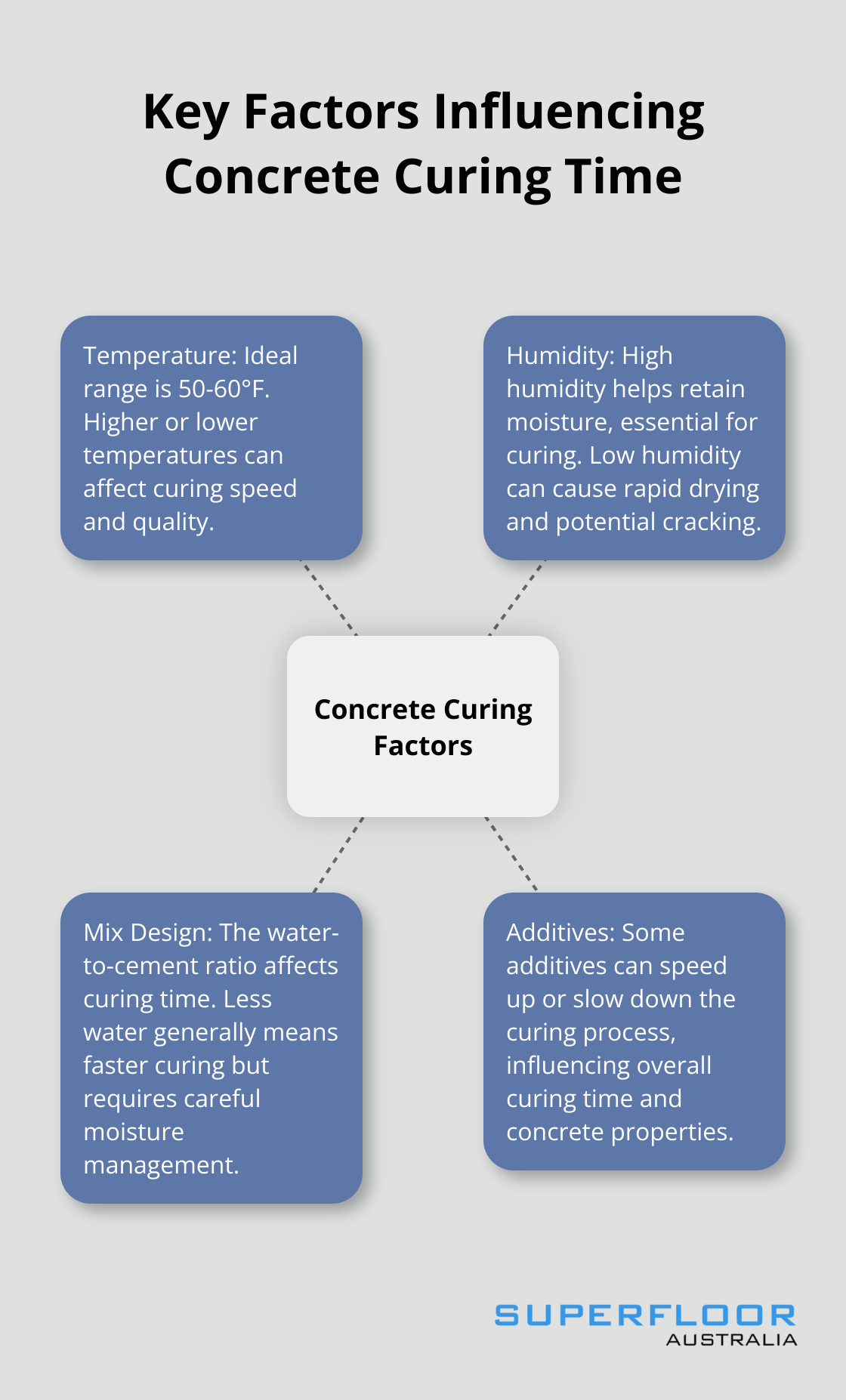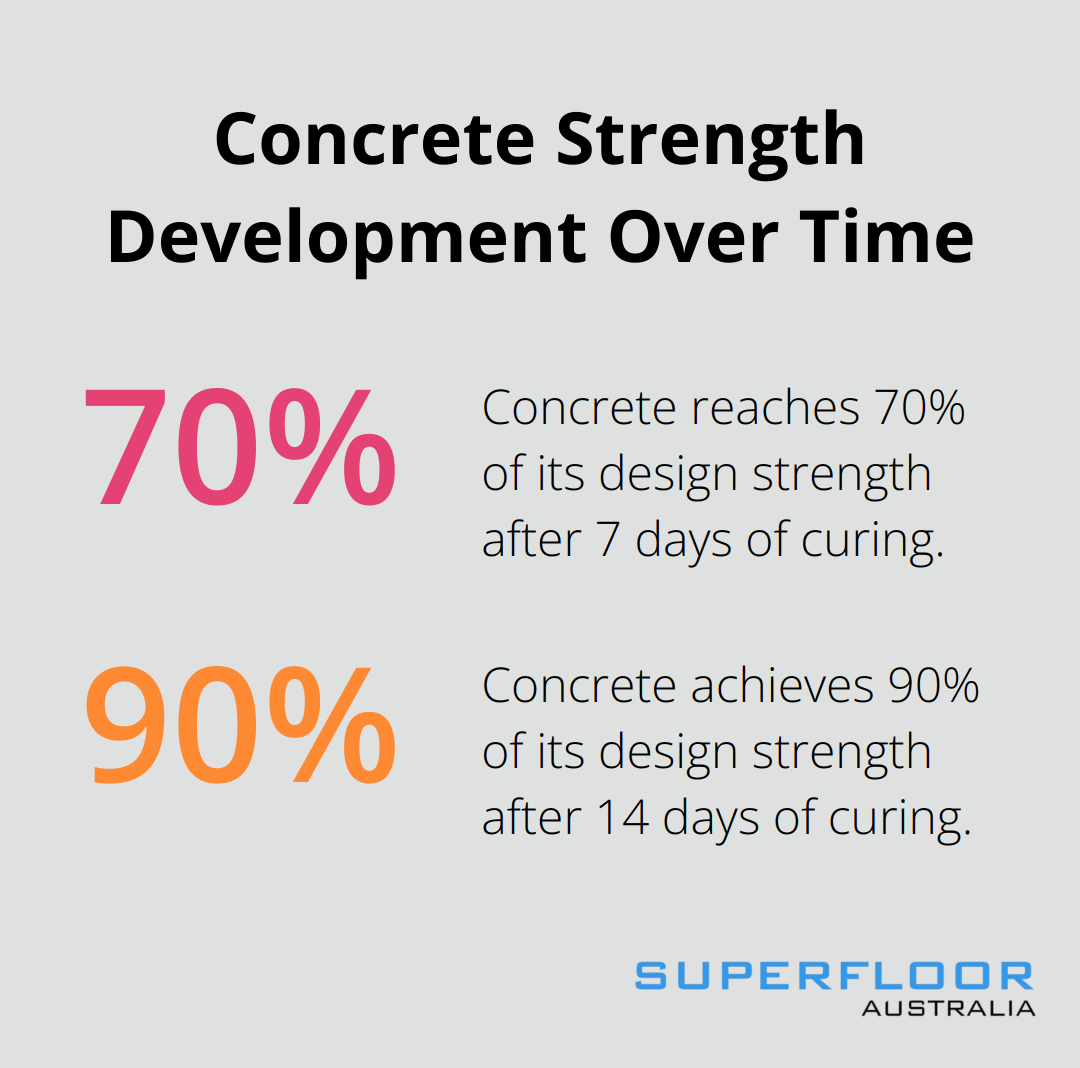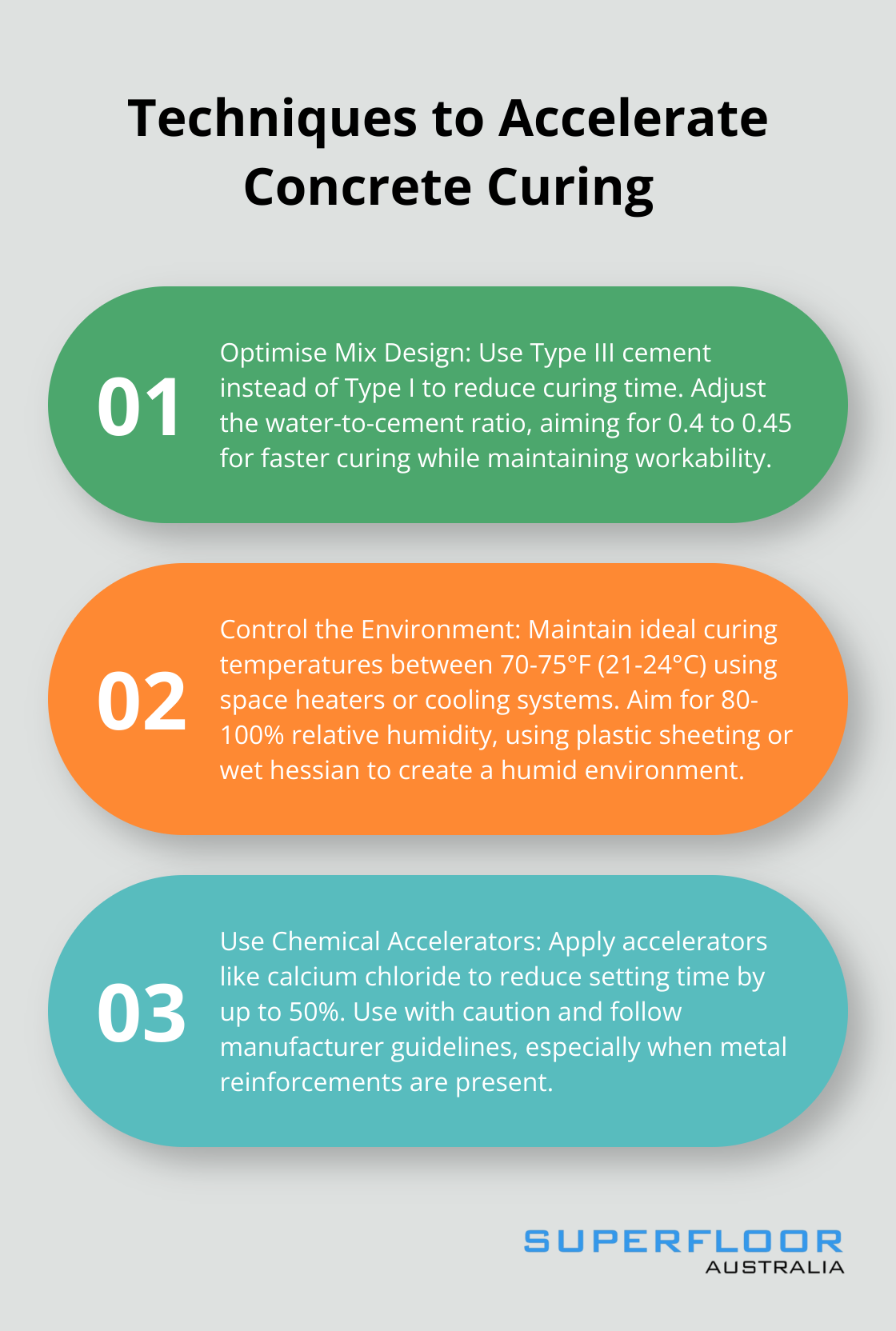At Superfloor Australia, we often get asked: “How long should concrete benchtops cure before polishing?” It’s a critical question for anyone looking to achieve a flawless finish on their concrete surfaces.
Proper curing is essential for the strength, durability, and appearance of concrete benchtops. In this post, we’ll explore the ideal curing times and techniques to help you achieve professional-quality results.
What Happens During Concrete Curing?
The Science of Concrete Curing
Concrete curing transforms liquid concrete into a solid, durable surface. This process involves a chemical reaction called hydration, where water and cement in the mixture form strong bonds, creating a solid structure. As concrete cures, it gains strength and becomes less porous. The reaction continues for weeks (even months) after the initial pour, but the first 7 to 28 days are most important for developing strength and durability.
Importance of Proper Curing for Benchtops
Proper curing is essential to prevent premature drying, cracking, and surface defects, ultimately contributing to the long-term performance and longevity of concrete benchtops. Rushed curing can result in weak spots, cracks, and a less polished finish. Adequate curing time produces a stronger, more resilient benchtop that resists staining and damage better.
Key Factors Influencing Curing Time
Several factors impact concrete curing time:

- Temperature: The ideal temperature for curing concrete is typically between 50 and 60°F. Curing temperatures above or below this range can lead to issues.
- Humidity: High humidity helps concrete retain moisture, which is essential for the curing process. Low humidity can cause rapid drying, potentially leading to surface cracks.
- Mix Design: The ratio of water to cement in the mix affects curing time. Less water generally means faster curing but requires careful moisture management.
- Additives: Some additives can speed up or slow down the curing process. For example, superplasticisers can reduce the water content while maintaining workability, potentially accelerating curing.
Tailoring the Curing Approach
Understanding these factors allows professionals to tailor their approach to each project, ensuring optimal curing conditions for every concrete benchtop. This knowledge helps create beautiful, long-lasting surfaces that meet specific project requirements.
The next chapter will explore the recommended curing times for concrete benchtops before polishing, building on this foundation of curing science and factors.
When Can You Polish Concrete Benchtops?
The Minimum Waiting Period
You should wait at least 2-3 days before you start to polish concrete benchtops. This waiting period allows the concrete to develop enough strength to withstand the mechanical stress of polishing. However, this is just a baseline. The American Concrete Institute suggests that concrete continues to gain strength for up to 28 days after pouring.
Optimal Curing for Best Results
For the best results, you should wait 2-3 days before polishing. This period allows the concrete to develop more strength and stability. It also reduces the risk of surface damage during the polishing process.
A study by the Portland Cement Association found that concrete reaches about 70% of its design strength after 7 days, and about 90% after 14 days. This extra strength can make a significant difference in the final polish quality.

Environmental Factors and Curing Time
The environment plays a key role in concrete curing. Temperature and humidity are particularly important:
Temperature Effects
Ideal curing temperatures range from 70-75ºF. Cooler temperatures slow down the curing process, while warmer temperatures speed it up.
Humidity Considerations
High humidity (above 80%) can slow down the curing process by preventing water evaporation from the concrete. On the other hand, low humidity (below 40%) can cause the concrete to dry too quickly, potentially leading to surface cracks.
Monitoring and Control
Professional concrete companies use specialised equipment to monitor and control these environmental factors, ensuring optimal curing conditions for every project. This level of precision (which includes temperature and humidity control) can significantly improve the final quality of the polished concrete benchtop.
Rushing the polishing process can lead to a subpar finish and potential long-term issues with your benchtop. It’s always better to wait longer than to start polishing too early. Your patience will result in a beautiful, durable, and long-lasting polished concrete benchtop.
Now that we understand the ideal timing for polishing, let’s explore some techniques that can help speed up the concrete curing process without compromising quality.
How to Accelerate Concrete Curing
At Superfloor Australia, we understand the importance of efficient concrete curing. While patience remains key, several techniques can speed up the process without compromising quality. Here’s how you can accelerate concrete curing for your benchtops:

Optimise Mix Design
One effective way to speed up curing involves adjusting the concrete mix. Use Type III cement instead of Type I to reduce curing time significantly. Type III cement’s fine grind increases its surface area and accelerates the hydration process. Soil-cement requires a definite curing period prior to the construction of additional base or wearing courses. This curing period is normally seven days when using Type III cement.
Another option reduces the water-to-cement ratio in your mix. Less water means faster curing, but exercise caution – too little water can cause workability issues. Start with a water-to-cement ratio of 0.4 to 0.45.
Control the Environment
Temperature and humidity play vital roles in concrete curing. The ideal curing temperature ranges between 70-75°F (21-24°C). Use space heaters or cooling systems to maintain this range. For humidity, try to achieve 80-100% relative humidity. Create a humid environment around your benchtop with plastic sheeting or wet hessian.
High temperatures affect the compressive strength of concrete. Above 212ºF, the cement paste begins to dry out (lose chemically bound water of hydration), which can lead to potential cracking.
Use Chemical Accelerators
Chemical accelerators can significantly speed up the curing process. Calcium chloride, a common accelerator, can reduce setting time by up to 50%. However, it may cause corrosion in metal reinforcements, so use it with caution.
Compared to non-chloride accelerators, CaCl2-based accelerators provide advantages with respect to both acceleration efficiency and cost and are the first choice for most applications. Always follow manufacturer guidelines when using accelerators.
Seal Properly
Sealing your concrete benchtop during curing helps retain moisture and heat, accelerating the process. Use a high-quality curing compound or plastic sheeting to seal the surface. Apply the sealer as soon as the concrete becomes firm enough to walk on without marring the surface.
These techniques can speed up curing, but don’t rush the process excessively. Proper curing remains essential for the long-term durability and appearance of your concrete benchtop. Always consult with professionals or conduct small-scale tests before applying these methods to your project. Use fans to improve air circulation, but avoid direct heat sources as they can cause uneven drying. A moisture meter can help you determine if your concrete is ready for the next step.
Final Thoughts
Concrete benchtops require patience and precision to achieve a perfect finish. The question “How long should concrete benchtops cure before polishing?” depends on various factors, but waiting 7-14 days often yields better results. Environmental elements like temperature and humidity significantly impact the curing process and final product quality.
Techniques to speed up curing include optimising mix design, using chemical accelerators, and proper sealing. However, these methods should be approached cautiously to maintain long-term quality. Monitoring and controlling environmental factors (such as temperature and humidity) can greatly improve the outcome of your concrete benchtop project.
We at Superfloor Australia specialise in high-quality polished concrete solutions. Our expertise ensures your concrete benchtops receive proper care throughout the curing and polishing process. Contact us to transform your space with stunning, durable polished concrete that will stand the test of time.
